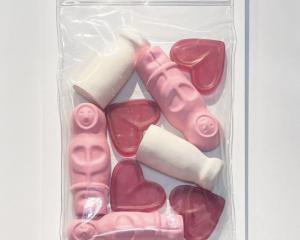"Side seam" (Inge Doesburg Gallery)
In all, eight artists are represented in the show, which covers a fascinating range of different styles and ideas.
Victoria McIntosh and Elfi Spiewack present works which, each in their own way, are highly poignant. Spiewack's pieces are three of very few rescued from the remains of the artist's studio in Christchurch; McIntosh's delicate framed collections and associated poems and lyrics are dedicated to late Dunedin artist Larry Matthews.
Also of note are the fine needlework moths of Jenna Packer, although it is fair to say all the works in the exhibition are of interest.
Doesburg's own work focuses on the connections between the artist's home in New Zealand and her original home in Germany.
Poetry plays an important part in the works, with the words of Heine, Goethe and Rilke stitched within the fabrics. The three items become in themselves an ode to the Rhine and to the journey.
"Tiefschwarz/New works", Sam Foley and Ben Ho (The Artist's Room)
The works are as strong, attractive, and well conceived as ever. The night scenes in particular beautifully capture the essence of the darkened city. Perhaps the most surprising element is that the German woodland paintings could easily be local scenes - a fact which the artist himself notes.
The forests become extensions of Southland beech forest and Bethune's Gully foothills - a clear indication that taking New Zealand out of the boy is harder than taking the boy out of New Zealand.
Foley's paintings are juxtaposed with a series of images by Ben Ho. These attractive pieces include soft-focus townscapes and Central Otago landscapes which nicely capture the region's light.
The highlight of Ho's paintings, however, are those which focus on bird-life, especially his images of sparrows. In these works, such as Autumn, he has excellently captured the spirit of these creatures as well as creating well-composed nature studies.
"Memory and Fabric/Walk/A Collection of Still Life", Rose McLeod, Kate Fitzharris and Nicola Hansby (Blue Oyster Gallery)
In Rose McLeod's display, clothes maketh the man, or rather shreds of clothes form a man's memory trace.
Like sloughing skin, the repeated paring away of layers of garment becomes a journey to the person's spiritual core and to the meaning of the artist's relationship with that person. A life's story is poignantly hinted at in these arrays of fragments of formerly loved clothes.
Kate Fitzharris' physical and psychological journey is documented in a Dunedin rosary of hundreds of beads, paying out the line of her path from Blueskin Bay to Moray Pl.
Each bead was hand-rolled from roadside debris and beeswax as she walked the 23km, the entire journey being presented as an exercise in sculptural psychogeography that is simultaneously impressive in construction and concept.
Nicola Hansby's still lifes form a simple array of watercolours and acrylics. There are layers here, however; objects are bound in cloth, photographed, then painted, leaving us often unaware of their original forms.
The cloth clothes the objects, giving only clues as to their nature - much like McLeod's jackets. The amorphous forms and statues thus become blank canvases on which our minds can create their own stories.








![Untitled (c. mid 1990s, [pink 3]), by Martin Thompson, 415mm×590mm. Photo: courtesy of Brett...](https://www.odt.co.nz/sites/default/files/styles/odt_landscape_small_related_stories/public/story/2024/02/untitled_pink_3.jpg?itok=Q0aQrc9o)



